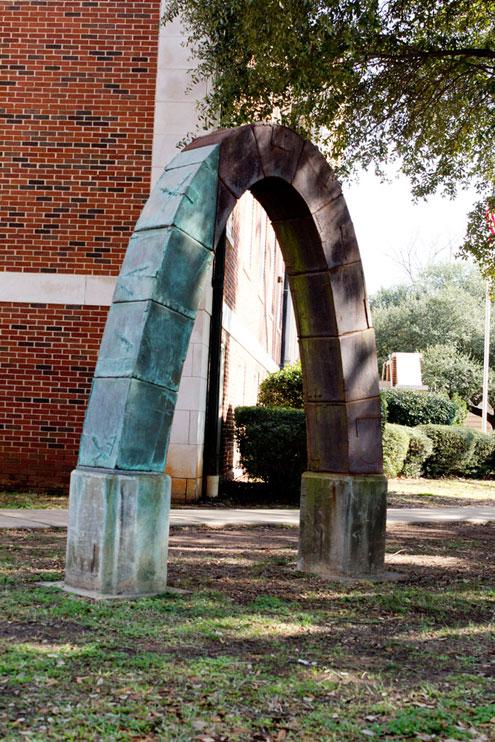“Have you seen it up close?” asked Rachel Dobson, communications specialist and visual resources curator for the College of Arts and Sciences, as she moved towards her Clark Hall office window, focusing her attention out and down. “The surface isn’t smooth.”
“It” is “Pent/La Buidhe Bealltain,” the arch sculpture standing outside of the ROTC and Arts and Sciences Programs Building. And it is anything but smooth.
The 11 thoroughly weathered cast iron and cast bronze blocks stacked to form the parabola appear to be covered with fissures, patches and patterns. The etched intersecting fibers on the sculpture’s tarnished bronze leg suggest stitched-up scars in durable blue-green skin.
The University purchased the arch, created by George Beasley, during the 1991 Alabama Biennial exhibition. According to the Smithsonian Institution Art Inventories Catalog, its name is Gaelic for “The Feast of the Yellow Fires of Bel.” In Scottish Highlands tradition, Bel is the sun.
There is purpose behind “Bealltain’s” multitude of textures. Beasley constructed the arch with the intention of people rubbing, feeling and generally experiencing the sculpture from close range.
As Christine Sneed wrote in the August/September 1991 edition of the Alabama Alumni Magazine, the sculptor wanted observers to “feel compelled to walk under and around his arch” and “to go ahead and touch the surface, to feel the symbols etched into the metal.”
UA community members have not allowed the artist’s wishes to go unfulfilled.
“I love it,” Dobson said. “I love the textures.”
The sculpture’s placement in a class-commute thoroughfare has provided many students the opportunity to develop their own interpretations of the arch’s aesthetic.
“I walk by it every day,” said Will Gillette, a sophomore majoring in English. “It looks like a beat up old earthworm crawling out of and back into the ground. It has the sections like an earthworm.”
Since its arrival on campus in 1991, the arch has managed to crawl from its first home, another high-traffic spot on campus, to its current residence. According to Becky Florence, director of college relations and associate director of development for the College of Arts and Sciences, “Bealltain” was originally placed on the southwest corner of the Quad, a location presently occupied by a campus map display.
“The arch was originally on the corner across from the education building, but it was moved when the University did some landscaping on the Quad,” she said.
The Alabama Biennial programs took place in 1991, 1993 and 1995, the products of an anonymous donation to the College of Arts and Sciences, accompanied by instructions to bring outdoor art of “heroic proportions,” according to Florence, for display on campus.
A total of 17 sculptures were displayed at the University for the program’s first incarnation, and two have stayed ever since. “Bealltain,” along with Be Gardiner’s “Icarus and the Guardian Angels,” were the two Biennial Purchase Award winners for the 1991 exhibition.
James Yarbrough, then dean of the College of Arts and Sciences, felt the exhibitions reflected the importance of UA life in general.
“Alabama Biennial sculptures on campus…contrast our sensibilities, ask us to reevaluate our ideas, and challenge us to consider new concepts – processes that are fundamental to university life,” he wrote in the brochure for the 1993 exhibition.
Discussing her opinion of the arch, Allie Michle, a freshman majoring in mathematics, echoed Yarbrough’s sentiment.
“It’s like a gateway into a new, artistic world,” she said.







